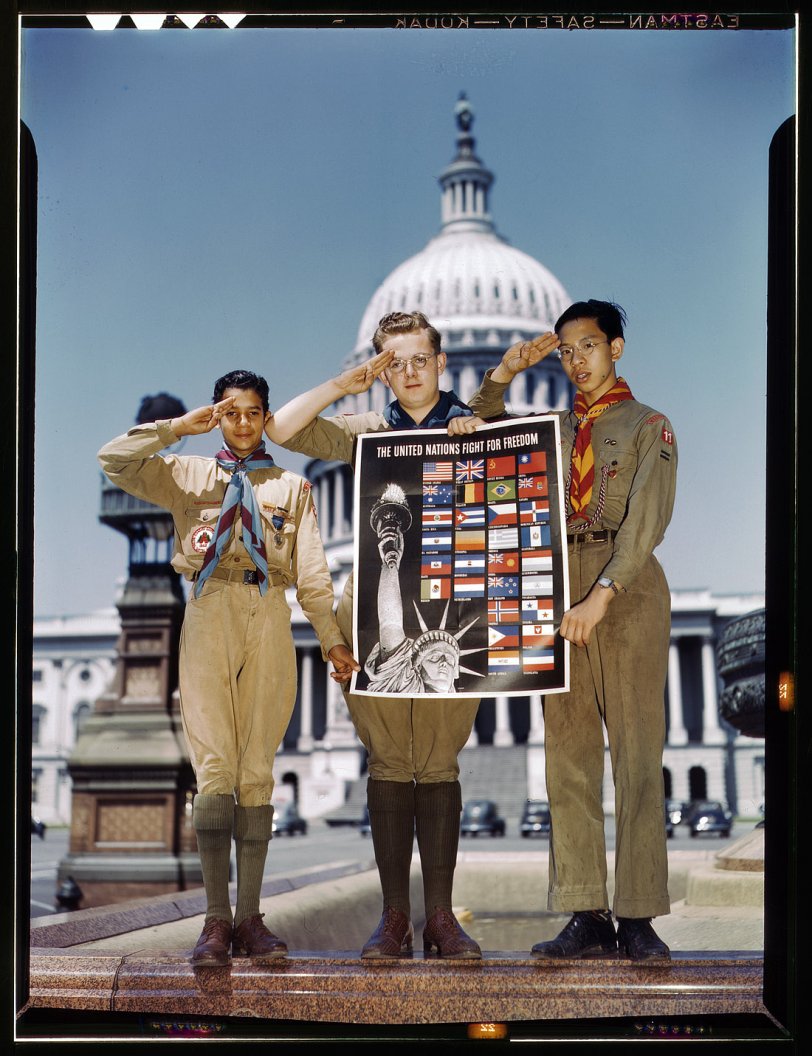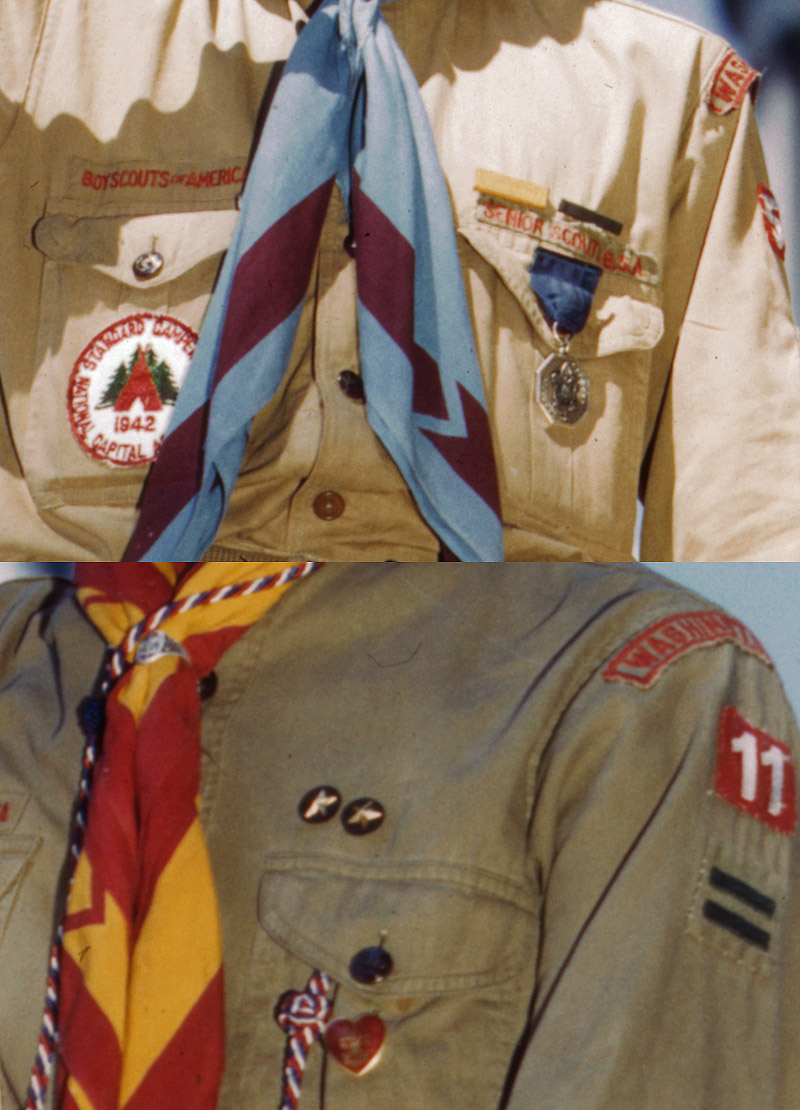


Framed or unframed, desk size to sofa size, printed by us in Arizona and Alabama since 2007. Explore now.
Shorpy is funded by you. Patreon contributors get an ad-free experience.
Learn more.

- Baldwin 62303
- Baldwin VO-1000
- Cold
- No expense spared
- Tough Guys
- Lost in Toyland
- And without gloves
- If I were a blindfolded time traveler
- Smoke Consumer Also Cooks
- Oh that stove!
- Possibly still there?
- What?!?
- $100 Reward
- Freeze Frame
- Texas Flyer wanted
- Just a Year Too Soon
- WWII -- Replacing men with women at the railroad crossing.
- Yes, Icing
- You kids drive me nuts!
- NOT An Easy Job
- I wonder
- Just add window boxes
- Icing Platform?
- Indiana Harbor Belt abides
- Freezing haze
- Corrections (for those who care)
- C&NW at Nelson
- Fallen Flags
- A dangerous job made worse
- Water Stop
Print Emporium
Fight for Freedom: 1943

Washington, 1943. "United Nations Fight for Freedom: Colored, white and Chinese Boy Scouts in front of Capitol. They help out by delivering posters to help the war effort." View full size. 4x5 Kodachrome transparency by John Rous for the Office of War Information. What photo expert out there can tell us about the numbers on these Kodachromes -- how and at what point in the manufacturing/ exposure/ developing process they were made, and what they signify.
Insignia
Couple of things I've noticed. First, the boy on the left - identified as "colored" - is actually, I believe, of Filipino heritage. I also think that the medal he is wearing is not a camping medal, but is - in fact - the older style of the Islamic "God and Country" award ("In the Name of God", as it's called now), which would fit in with the boy being Filipino. Also, despite his shorter stature, the patch above his pocket identifies him as being a "Senior Scout" - the predecessor to the 1950s' "Explorer Scout", or today's Venturer - meaning that he was at least 15, at the time. This may also explain why he, and the boy in the middle, appear to have lighter-color uniforms, and the difference in the trouser legs. The Scout on the right, by contrast, can be seen to lack the "Senior Scout" patch on his uniform, meaning that he is 14 or less (the "up-grade" at 15 was automatic), which would tie in with the two single-year pins on his uniform. The cord is not a Den Chief's cord - which would be blue and gold and worn on the shoulder - but is probably, as someone has suggested, a whistle lanyard; this would tie in with his Patrol Leader insignia.
Eagle Scout here
DPatten, Thanks for the analysis. I have one of those Life Scout pins. The Scout on the left has a "Senior Scout BSA" patch over his left pocket. I have to check my 1942 Boy Scout Handbook. Wasn't the braid for Den Chief a loop hanging from the right shoulder around the right arm? That was the case when I was in the Scouts 1968-1978. This braid seems to be a whistle lanyard.
Photographer John Rous
The photographer is my uncle, now deceased, but I have many of his photographs, 2 scrapbooks compiled by his wife, Connie Hicks Rous. I also have his ID card from the war department. John Rous later worked for the Associated Press covering the White House.
I have just discovered this site today and will see what how I can contribute more of his work.
The pants
I wonder if the war period was the transition between the knicker-type scout pants of the 30s and regular trousers. My dad was a scout in the 30s and wore the knickers. Here the two on the left look like their socks are just pulled up over their cuffs, while the Chinese scout is wearing last year's too-short pants. Note also the uniforms are different shades of khaki - perhaps due to reusing older uniforms or having to use various fabric sources during the war.
Kodachrome
The row of dots along the bottom are marks left by the film holder used in development.
Gene is correct, the yellow square with 22 and other info is indeed from a user supplied 'ID' exposed into the film.
The notches on the upper left are the notch code identifying the emulsion for loading in the dark.
Boy Scouts
This is a great Boy Scout picture! As a former Eagle Scout I am happy to see it.
The young man on the right is wearing a pin on his left pocket indicating that he is a Life Scout, the rank just below Eagle Scout. The two bar patch on his left arm shows that he is a Patrol leader. The red white and blue cord on his shirt is a service award indicating that he was a "Den Chief" for more than a year. A Den Chief is an older Boy Scout who mentors Cub Scouts. He appears to have two "service stars" indicating the number of years that he was in the Boy Scouts or Cub Scouts. He is from Troop 11 in Washington DC according to his shoulder patches.
The boy on the left has no rank that I can discern, but if he is wearing a pin instead of a patch, it would be obscured by what appears to be a camping contest medal. He also has a 1942 Camporee patch on his right shirt pocket.
He also is from DC but from a different troop, starting with a 5
Unfortunately, since they are saluting, I can't tell you what patrol they were in.
I was kind of surprised to see the Pin on the Life Scout rather than a patch, But I suppose during the war the demands for Army uniforms was higher on the production boards lists than Boy Scout uniforms.
The Poster
Numbers on film
These numbers are exposed on the rebate of the film by a specially modified, or factory made 4x5 film holder at the time the original shot was taken. This is quite common, and several manufacturers made film holders that would allow for this, as well as many photographers modified their existing film holders to identify individual frames. These Kodachrome transparencies are 4x5" individual sheets of film, not a "roll" of film. The Individual 4x5 sheets of film had to be loaded into film holders in the dark by the photographer before his assignment. No 4x5 film has ever had factory applied numbers other than for film type, and these numbers are not relating to film type.
Number on print
I'm going to guess the numbers come from the film strip itself. This is the 22nd exposure on the roll. At the very least that makes sense to me as 35mm film has similar numbers on it to this day...
[There is no roll. This is sheet film. And this isn't a print, it's a transparency. - Dave]
The numbers
I know that the numbers are exposed during manufacture. however I don't know what they mean.
The notches at the top are the "notch code" which tells you what brand and ISO film you're using. I'm not an expert, i'm just taking a large format class right now.
[The numbers aren't "exposed." On this example they are holes punched in a little piece of paper, covering up a hole in the film. There is what looks like a date (N 28 1943) stamped in ink under the 22. Another frame from this shoot, showing just one scout, also has the number 22 on it. On other 4x5 Kodachromes the numbers are clear dots in the emulsion itself and there is no little piece of paper and no date. - Dave]



























On Shorpy:
Today’s Top 5